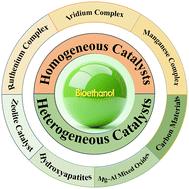Advances in catalytic conversion of ethanol to higher alcohols as liquid fuels and aviation fuel precursors
IF 9.2
1区 化学
Q1 CHEMISTRY, MULTIDISCIPLINARY
引用次数: 0
Abstract
As a renewable green energy source, the catalytic upgrading of ethanol to higher alcohols (C4+) represents a critical pathway to overcome its inherent fuel limitations. C8–C16 isomer groups within higher alcohols are utilized as pivotal intermediates in synthesizing sustainable aviation fuels (SAFs) via hydrodeoxygenation—a catalytic process critical for meeting globally mandated emission reduction targets in the aviation sector. This review comprehensively analyzes reaction mechanisms and catalyst design strategies for ethanol valorization, emphasizing the pivotal roles of acid-base synergy, metal-support electronic interactions, and dynamic intermediate regulation. While non-precious metal catalysts demonstrate scalable potential, challenges persist in aqueous-phase stability and long-chain selectivity. Future breakthroughs demand the integration of in situ characterization and multiscale simulations to engineer robust, water-tolerant catalytic systems, ultimately advancing the high-value transformation of bioethanol into drop-in biofuels and SAF precursors.

乙醇催化转化为高级醇作为液体燃料和航空燃料前体的研究进展
乙醇作为一种可再生的绿色能源,催化升级为高级醇(C4+)是克服其固有燃料限制的重要途径。高等醇中的C8-C16异构体基团被用作通过加氢脱氧合成可持续航空燃料(SAFs)的关键中间体,这是一种催化过程,对实现全球规定的航空部门减排目标至关重要。本文综合分析了乙醇增值的反应机理和催化剂设计策略,强调了酸碱协同作用、金属支持电子相互作用和动态中间调节的关键作用。虽然非贵金属催化剂显示出可扩展的潜力,但在水相稳定性和长链选择性方面仍然存在挑战。未来的突破需要将原位表征和多尺度模拟相结合,以设计出稳健、耐水的催化系统,最终推进生物乙醇向可直接使用的生物燃料和SAF前体的高价值转化。
本文章由计算机程序翻译,如有差异,请以英文原文为准。
求助全文
约1分钟内获得全文
求助全文
来源期刊

Green Chemistry
化学-化学综合
CiteScore
16.10
自引率
7.10%
发文量
677
审稿时长
1.4 months
期刊介绍:
Green Chemistry is a journal that provides a unique forum for the publication of innovative research on the development of alternative green and sustainable technologies. The scope of Green Chemistry is based on the definition proposed by Anastas and Warner (Green Chemistry: Theory and Practice, P T Anastas and J C Warner, Oxford University Press, Oxford, 1998), which defines green chemistry as the utilisation of a set of principles that reduces or eliminates the use or generation of hazardous substances in the design, manufacture and application of chemical products. Green Chemistry aims to reduce the environmental impact of the chemical enterprise by developing a technology base that is inherently non-toxic to living things and the environment. The journal welcomes submissions on all aspects of research relating to this endeavor and publishes original and significant cutting-edge research that is likely to be of wide general appeal. For a work to be published, it must present a significant advance in green chemistry, including a comparison with existing methods and a demonstration of advantages over those methods.
 求助内容:
求助内容: 应助结果提醒方式:
应助结果提醒方式:


